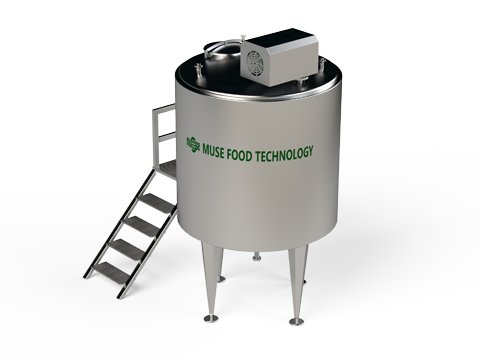
Purpose of Whey Tanks
Whey tanks are primarily used for the following purposes:
Collecting whey (cheese byproduct) released during cheese production,
Temporarily storing and transporting whey,
Processing whey for further utilization (e.g., whey powder production, protein isolates),
Maintaining hygienic storage conditions.
Material Selection
Stainless Steel (AISI 304 or AISI 316): Corrosion-resistant, hygienic, and long-lasting.
Polyethylene (PE) or Polypropylene (PP): More economical and lightweight alternatives, though with lower mechanical strength.
Double-Walled Design: Used when thermal insulation is required.
Design Features
Cylindrical Body: Ensures pressure resistance and ease of cleaning.
Conical or Flat Bottom: Sloped base preferred for complete drainage.
Agitator (With or Without Mixer): Mechanical agitators are added when homogeneous mixing is needed.
Air Lock and Filtration System: Ventilation filters prevent contamination.
Drain Valve and Hose Connection: Equipped with suitable fittings for whey transfer.
Capacity and Sizing
Small Scale (100–1,000 L): For small dairies and pilot plants.
Medium Scale (1,000–10,000 L): Used in medium-sized cheese production facilities.
Industrial Scale (10,000 L and above): For large-scale dairy processing plants.
Whey tanks are manufactured in different types based on their intended use:
Fixed Whey Tanks
Permanently installed within factories.
Connected to other equipment via pipelines.
Typically used in high-capacity facilities.
Mobile Whey Tanks (Portable)
Equipped with wheels or designed for forklift transport.
Ideal for small businesses or temporary storage.
Fitted with hygienic connection components.
Heated/Cooled Whey Tanks
Cooling-jacketed models to prevent whey spoilage.
Heating-equipped versions for whey processing.
Technical Standards and Hygiene Conditions
Whey tanks must comply with the following food safety and sanitation standards:
EHEDG (European Hygienic Engineering & Design Group)
FDA (U.S. Food and Drug Administration)-approved materials
3-A Sanitation Standards
ISO 9001 and ISO 22000 Quality Management Systems
Cleaning and Sanitation (CIP System)
Tanks can be cleaned using Clean-in-Place (CIP) systems.
Smooth surfaces prevent bacterial adhesion.
Resistant to chemical and thermal disinfection.
Maintenance and Usage Considerations for Whey Tanks
Regular Gasket Inspection: Worn gaskets may cause leaks.
Preventing Corrosion: Thorough rinsing is necessary, especially after using chlorine-based cleaners.
Agitator Maintenance: Bearings and motors of mechanical agitators should be checked regularly.
Pressure and Temperature Monitoring: Temperature sensors in heated/cooled systems must be inspected routinely.


